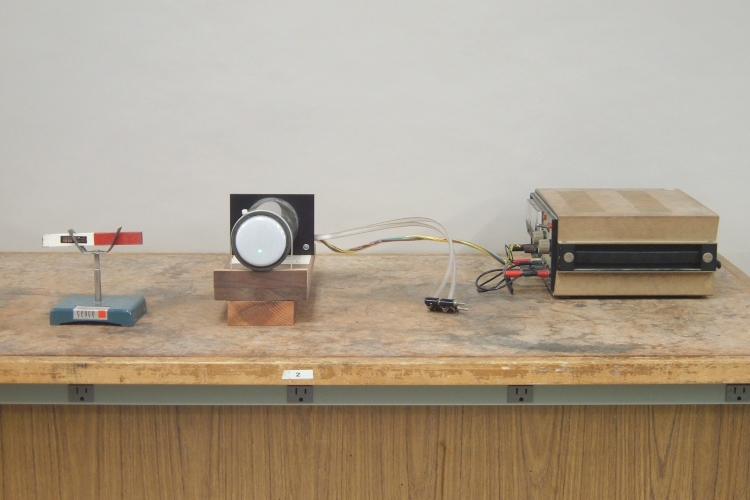
Flip the switch on the power supply from “Standby” to “On.” A green spot should appear in the center of the screen. (If it does not appear, touch the pins on the double banana plug; this will discharge the deflection plates, and the spot will appear.) Bringing the magnet toward the CRT causes the spot to move in a direction that depends on the orientation of the magnet, and over a distance that depends on how close you bring the magnet.
The earliest cathode ray tube, or CRT, enabled J.J. Thomson to establish the identity of the electron as a fundamental particle, and to determine its charge-to-mass ratio, e/m. (In a footnote to the section about the discovery of the electron, in Physics, Part Two, Robert Resnick and David Halliday write that evidence exists that a German physicist named Weichert discovered the electron several months before Thomson.) A cathode ray tube is an evacuated glass envelope having a cathode at the back, and an anode some distance in front of it. A filament near the cathode heats it, “boiling” electrons off it. A potential placed between the cathode and the anode accelerates these electrons through the tube, at the front face of which they strike a phosphor screen. Where the electrons hit the screen, they excite the phosphor, causing it to fluoresce and produce a (bright) spot on the screen. Pairs of plates, placed at right angles to each other between the anode and the screen, allow one to deflect the electron beam, or “cathode ray,” up, down, left or right as desired. By using a pair of deflection plates, measuring the beam deflection for a particular deflection potential, and then applying a uniform magnetic field to cancel the deflection, Thomson was able to calculate e/m for the electron. (It is -1.75882001076 × 1011 C/kg. Its charge is -1.602176634 × 10-19 C, and its mass is 9.1093837015 × 10-31 kg.*)
Not only was the cathode ray tube a useful research tool by itself, but in suitably modified and refined form, it was the heart of the oscilloscope (first known as the cathode ray oscilloscope), the television set and displays for computers and video equipment. While many such devices still contain cathode ray tubes, most now use liquid crystal or LED flat-panel displays instead.
Both this demonstration and the next one in the catalogue (68.34 -- Cathode ray tube, coil) show the deflection of an electron beam by a magnetic field. In demonstration 68.34, a current flowing through a coil generates the magnetic field. In this demonstration, a bar magnet provides the magnetic field. In both of these demonstrations, there is no potential applied to either pair of deflection plates in the CRT, so without an external magnetic field, the electron beam is undeflected and hits the center of the screen.
The force on a charged particle moving through a magnetic field is F = qv × B. If a test charge, q, moves with a velocity v through a region where a magnetic field is present, and it experiences a force F, we can define the magnetic field, B, as the vector that satisfies this equation. From this equation, we can see that the units of B are newton/(coulomb(meter/second)), or newton/(ampere·meter). This combination of units is called the tesla. The magnitude of the force is F = qvB sin θ. In the photograph above, the electrons are, of course, coming toward the front of the table. The magnetic field lines enter the south pole of the bar magnet and leave the north pole, so there is a component of the magnetic field that goes from left to right across the cathode ray tube. The cross product of these two vectors points upward, but since q is negative, the sense of the cross product is opposite, it points downward, and the spot appears below the center of the screen. Rotating the magnet so that it is more nearly perpendicular to the CRT axis, or bringing it closer to the CRT, lowers the spot even further. Rotating the magnet so that the south pole faces the CRT (on the same side), of course, deflects the beam upward. You can, of course, place the magnet along a vertical axis and deflect the beam sideways, or place the magnet along other axes to deflect the beam in other directions.
In the apparatus used in this demonstration, the voltages on the cathode and the anode are, respectively, approximately -110 and +350 volts, so the electrons acquire a total kinetic energy of about 460 electron-volts by the time they exit the electron gun of the CRT. In joules, this energy is (460 eV)(1.602 × 10-19 J/eV) = 7.37 × 10-17 joules. Kinetic energy, K, equals (1/2)mv2, so v = √(2K/m), and v = √(2(7.37 × 10-17 J)/9.11 × 10-31 kg), or 1.27 × 107 m/s.
A rough measurement with a Hall probe shows that with the magnet oriented as in the photograph, the perpendicular component of the magnetic field near the center of the CRT, roughly where the magnet axis meets the center line of the CRT, is probably about 1.5 gauss, or 1.5 × 10-4 tesla. So the force that an electron experiences on its way to the screen of the CRT is on the order of (1.602 × 10-19 C)(1.27 × 107 m/s)(1.5 × 10-4 T) = 3.0 × 10-16 N.
*These values are from the Committee on Data for Science and Technology (CODATA) 2018 data set.
References:
1) Halliday, David and Resnick, Robert. Physics, Part Two, Third Edition (New York: John Wiley and Sons, 1977), pp. 718-21, 736-7.